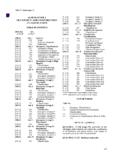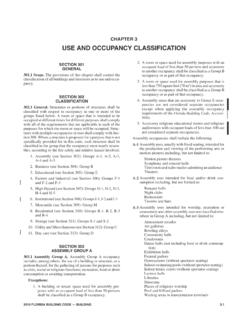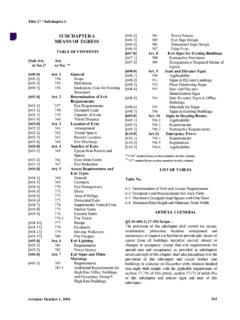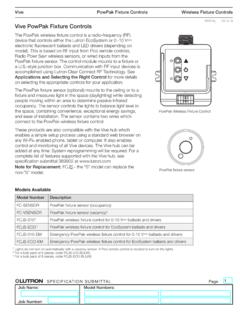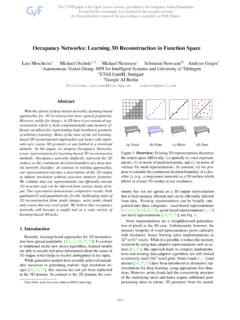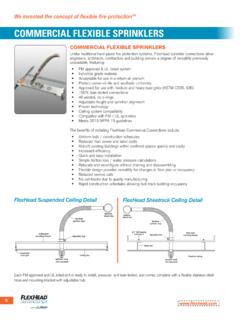Transcription of TABLE OF CONTENTS - Energy
1 TABLE OF CONTENTS . 1 INTRODUCTION. FEMP-DESIGNATED PRODUCTS. Energy EFFICIENCY METRICS. 3 DESIGN PROCESS. STEP-BY-STEP OVERVIEW. 6 COMPONENTS OF THE DESIGN. BUILDING DESIGN CONSIDERATIONS. MATERIAL SELECTION. LIGHTING DESIGN CONSIDERATIONS. LUMINAIRE DISTRIBUTION. COLOR QUALITIES. LUMINAIRE LAYOUT. 13 PARKING STRUCTURE LIGHTING DESIGN. DESIGN SCENARIO OVERVIEW. DESIGN SCENARIO GENERAL LUMINAIRE. DESIGN SCENARIO FEMP-DESIGNATED LUMINAIRE. 17 LIGHTING CONTROLS SAVE Energy . PHOTOSENSORS. occupancy SENSORS. 20 COST-EFFECTIVENESS. 21 RESOURCES. National Renewable Energy Laboratory's parking structure utilizes many measures to achieve a parking structure that uses 90% less Energy than the baseline Energy code. PARKING STRUCTURE LIGHTING GUIDE 1. INTRODUCTION. Legislation and the Federal Acquisition Regulations (FAR) require federal agencies to specify and buy Energy STAR qualified products or, in categories not included in the Energy STAR program, products that meet or exceed efficiency requirements designated by the Federal Energy Management Program (FEMP).
2 Agencies that follow requirements to buy efficient products can realize substantial operating cost savings and reduce pollution. As the world's largest consumer, the federal government can lead the entire market achieve greater Energy efficiency while saving taxpayer dollars. FEMP provides acquisition guidance and federal efficiency requirements across a variety of product cate- gories, including parking garage luminaires, which are a FEMP-designated product category. Federal laws and executive orders mandate that agencies meet these efficiency requirements in all procurement and acquisition actions that are not specifically exempted by law. The purpose of this guide is to explain in greater detail the FEMP-designated parking garage/structure product category, to show how the equipment can be used to maximize total Energy efficiency (using the metrics defined below), and to provide an estimate of the cost effectiveness using FEMP-designated products. Energy EFFICIENCY METRICS.
3 There are different Energy efficiency metrics. Although there are several metrics to describe Energy efficiency, here we consider three lighting-specific metrics: efficiency (very simple), efficacy (simple), and lighting power density (complex). This guide primarily focuses on efficacy, and demonstrates how efficacy incorporated with other elements can reduce power densities. Efficiency Efficiency is a measure of how effectively a device converts input into output. Luminaire efficiency (LE) is the light leaving the luminaire divided by the light generated by the bare lamp (light bulb) when operated outside of the luminaire. Because both values (the light leaving the luminaire and the light generated by the light source[s]) have the same unit, luminaire efficiency is therefore a unitless ratio. Efficacy Efficacy is the capacity to produce an effect. In lighting, efficacy is measured in lumens per watt (lm/W, also abbreviated LPW). Efficacy can apply to light sources or luminaires.
4 The greater the efficacy, the more light is generated for the same watts. Most people are familiar with this metric related to vehicles; for example, a car that gets 30 miles per gallon is more efficacious than a car that gets 25 miles per gallon. FEMP's designated product for lighting focuses on luminaire efficacy and uses the term luminaire efficacy rating (LER). The following page explains how to calculate the LER as well as the relationship between lumi- naire efficiency and luminaire efficacy. A key note regarding efficacy is that it counts the emitted lumens irrespective of the direction in which they are emitted, or the usefulness of those lumens. A luminaire can have a lower LER but do a better job of dis- tributing light to the task. Lighting Power Density (LPD). Lighting power density (LPD) is the total input power ( , including the driver or ballast) multiplied by the total number of luminaires divided by the area in which the equipment is installed.
5 Many Energy codes use this metric, however; it does not actually focus on Energy . Energy is power multiplied by time, so it is impor- tant to distinguish between power (watts) and Energy (watt-hours). Lighting power density calculations do not indicate any Energy savings as a result of the use of lighting controls. 2 PARKING STRUCTURE LIGHTING GUIDE. FEMP-DESIGNATED PRODUCTS. As of September 2013, there are FEMP-designated products for lamps (light bulbs), ballasts, interior fluo- rescent luminaires, industrial high-bay luminaires, and many exterior luminaires. The metric for luminaires is LER. The following provides the LER value for parking garage (also referred to as parking structures in this guide) luminaires as well as helpful calculations. MEETING Energy EFFICIENCY REQUIREMENTS FOR PARKING GARAGE LUMINAIRES. Parking garage luminaires must have a LER of 70 in order to be FEMP-designated (as of the date of this publication, the most current value as well as FEMP-designated products can be found at Covered Product Category: Exterior Lighting).
6 The following explains how to calculate LER for conventional light sources such as fluorescent, metal halide, and induction lighting, as well as light-emitting diode (LED) luminaires. total light leaving the luminaire LER =. input power Conventional Luminaires Conventional luminaires (non-LED) can use different combinations of lamps, ballasts, and optics, often requiring LER to be calculated. If an LER is not available, buyers may estimate the LER using this formula: Luminaire efficiency x lamp lumens LER =. lamp+ballast input watts LE x lamp lumens, and lamp+ballast (system) input watts are typically found in manufacturers' product catalogs and photometric reports. The LER formula may be used with generally-available component performance data to determine the minimum performance of other components. For example, known values may be used to calculate the lowest LE necessary to meet an LER requirement: A 150-watt high pressure sodium (HPS) lamp produces 15,250 initial lumens with 185 lamp+ballast input watts.
7 What LE is necessary to meet the minimum required LER of 70? LER lamp+ballast input watts 70 lm/W 185 W. LE = = = lamp lumens 15,250 lumens Therefore, for a minimum required LER of 70, a fixture combined with the lamp and ballast values pro- vided must have an LE of at least 85%. LED Luminaires LED luminaires are available in different combinations, but their values are reported for the complete luminaire, not the light source by itself. The complete LED housing includes the fixture, light source (or lamp), and driver (similar to a fluorescent ballast). If an LER is not available, buyers may calculate the LER for LED luminaires using this formula: luminaire light output (lumens). LER =. input power (watts). DESIGN PROCESS. The rest of this document will explain options for Energy efficient lighting in parking structures using FEMP-designated luminaires and features accounting for both lighting quality and Energy efficiency. Selecting Energy efficient equipment, such as FEMP- designated equipment is the first step in Energy efficient parking structure lighting.
8 This section addresses a step-by-step process from surveying the site to installation. Key points of the following design process section include: 1. Developing an inventory of equipment 2. Determining lighting quality and quantity needs 3. Incorporating lighting controls 4. Addressing cost effectiveness in the process 4 PARKING STRUCTURE LIGHTING GUIDE. PARKING STRUCTURE LIGHTING DESIGN: A STEP-BY-STEP OVERVIEW. STEP 1: CONDUCT COMPLETE INVENTORY. Consider all lighting opportunities and list which luminaires you want to replace, and ask why you want to replace them. Is Energy the only issue? If this is a retrofit, be sure to collect information on each existing luminaire that you want to replace ( , lamp type(s), mounting height of luminaires, general lighting information). Ramps and entrance areas may use different luminaire types than basic parking areas. STEP 2: CONSIDER LIGHT QUANTITY AND QUALITY. When considering parking garages, it is common to assume one uniform light level, night or day, is appropriate.
9 The Illuminating Engineering Society of North America (IES) recommends a low light level for basic parking areas and higher light levels for ramps and higher still for entrance areas. Additionally, since most parking garages are lighted 18+ hours per day, ramps and entrance areas should have even higher light levels during daylight hours to help the eye adapt from bright sunshine to the darker interior of the parking structure, or vice versa. Controls should be used to reduce those high light levels at night to help drivers transition from the lighted parking structure to the darker conditions of the street outside the structure. Lighting uniformity on the pavement surface must also be considered for safe vehicle and pedestrian interaction. Too much contrast between bright and darker areas makes it more difficult to see people and vehicles in the darker areas. Luminaires that dis- tribute light evenly on the garage floor and onto interior walls, and lighting layouts with appropriate spacing, are crucial to the lighting design.
10 Consequently, one-for-one replacement may not be an option when specific light levels and uniformity ratios are targeted. Consider recommending light surface colors, as lighting ceilings and vertical surfaces will increase reflected light in the garage, improving light levels and uniformity of light on the floor as well as making pedestrians and their faces more visible. You can refer to IES resources or your local lighting professional for assistance. Contact the International Association of Lighting Designers and/or the Illuminating Engineering Society of North America to locate lighting professionals. STEP 3: CONSIDER CONTROLS FOR TRANSITION AREAS. Using controls to adjust light levels for changing daylight and occupant activity will help save Energy . Parking garage ramps and entrance areas require higher light levels during daylight hours, as described earlier. Consider adding photosensors to reduce ramp and entrance lighting levels to save additional Energy at night.










